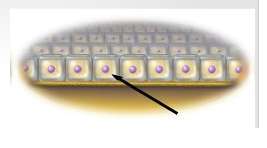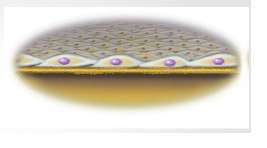Cell Continually Takes in Droplets of Extracellular Fluid Into Vesicles
-
Single long structure with axoneme core
Flagellum
-
folds of cell membrane; may have actin core?
MIcrovilli
-
7 to10 um long with axoneme core
Cilia
-
The control center of cellular activity is the ___?
Nucleus
-
Name the organelle comprised of stacking cisternae that synthesize carbohydrates?
Golgi complex
-
___ is the scientific study of cells.
Cytology
-
Large particles and fluid droplets are moved across the membrane by a process called:
Vesicular transport
-
Which of these organelles is surrounded by membranes?
ribosomes
mitochondria
centrioles
centrosomesMitochondria
-
The vesicular transport process of discharging material from a cell is called?
exocytosis
-
A fatty acid lipid to which several sugars are attached.
Glycolipid
-
___ are the organelles that digest and dispose of worn-out mitochondria and other organelles by a process called autophagy.
Lysosomes
-
Lysosomes digest and dispose of warn-out mitochondria and other organelles by a process called ____.
autophagy
-
The ________ is an extensive system of cytoplasmic tubules or channels classified as rough or smooth depending on the presence of ribosomes.
Endoplasmic reticulum
-
Name the membrane-bound organelles that contain enzymes and oxygen to be used to oxidize organic material.
Peroxisomes
-
The brush border on the apical surface of cells is composed of cellular extentions called _____.
Microvilli
-
The fluid located between the cells that baths the cells is called the:
Interstitial
-
The physical force generated by a liquid such as blood or tissue fluid is known as ____ pressure.
Hydrostatic
-
______ pressure is the hydrostatic pressure needed on one side of a semi-permeable membrane to halt osmosis.
Osmotic
-
A cell placed into a ______ solution will lose water by osmosis.
Hypertonic
-
A _____ solution has a lower osmotic pressure than the cell and causes cells to gain water.
hypotonic
-
A ______ solution has a lower somotic pressure than the intracellular fluid of the cell and tends to cause osmotic swelling and lysis of cells.
Hypotonic
-
The ability of a solution to cause osmosis, affection volume and pressure in the cell is called _____
tonicity
-
Mechanisms for moving substances across the plamsa membrane that require the use of cellular ATP include which of the following?
Passive diffusion
active transport
vesicular transport
osmosis- Vesicular transport
- and active transport
-
_____ are the organelles that read coded genetic messages and assemble amino acids into proteins.
Ribosomes
-
___ is a short cylindrical assembly of microtubules arranged in nine groups of three microtubules.
Centriole
-
Give the general name for the network of structures within the cytoplasm which support the cell, determine its shape, and participate in movement.
Cytoskeleton
-
The more nonpermeating solute present in a solution, the higher/lower the osmotic pressure of that solution.
Higher
-
Name the whiplike sturcture similar to a cilium but with a longer length.
flagella
-
The cytoskeleton is a system of ________, _______ and _______ that give the cell shape, allow movement, and the routing of molecules and organelles within the cell.
microfilaments, intermediate filaments, and microtubules
-
name the process that involves a secretory vesicle fusing with a cell membrane and releasing its contents to the extracellular space.
Exocytosis
-
Three types of endocytosis
- pinocytosis
- phagocytosis
- receptor-mediated endocytosis
-
What is this cell shape?Cuboidal
-
A ____ solution has a lower osmotic pressure than the cell and causes cells to gain water and lyse.
Hypotonic
-
a _____ solution has a higher osmotic pressure than the intracellular fluid of cells and tends to cause the cells to undergo osmotic shrinkage.
Hypertonic
-
______ are glycoprotein compounds on the cell surface that allow the body to distinguish the body's cells from foreign cells.
Cell-identity marker
-
Name the carrier type that moves two solutes, such as glucose and sodium, in the same direction across a membrane.
cotransport
-
Name the cell type.squamous
-
Voltage-regulated gates respond to changes in _______ across the plasma membrane.
Electrical potential
-
Which of the following are examples of passive transport?
Osmosis
Passive Diffusion
Pinocytosis
Facilitated Diffusion
Vesicular transport
Filtration- Osmosis
- Passive Diffusion
- Facilitated diffusion
- Filtration
-
A protein that is not integral to the plasma membrane and is often attached to the cytoskeleton is a _______ protein.
Peripheral
-
Which of these would NOT increase the rate of diffusion?
Larger concentration difference
Small molecular weight of diffusing compound
Decrease in temperature
Large cellular surface areaDecrease in temperature
-
On the surface of epithelial cells within the respiratory tract, uterine tubes, testes, and ventricles of the brain are found _____ which aid in moving fluids or cells through these structures.
Cilia
-
Name the fine thread-like genetic material (DNA) found within the nucleus of a non-dividing cell.
Chromatin
-
Give the general name for the network of structures within the cytoplasm which support the cell, determine its shape, and participate in movement.
Cytoskeleton
-
The cell process in which the membrane invaginates, forming vesicles that bring extracellular particles or droplets of fluid into the cell, is known as ________.
endocytosis
-
Name the carrier type that moves two solutes, such as glucose and sodium, in the same direction across a membrane.
Symport
-
A carrier that transports only one type of solute at a time is called a __.
Uniport
-
The molecule primarily responsible for stiffening the cell membrane is _____.
Cholesterol
Source: https://freezingblue.com/flashcards/169526/preview/a-p-cells-connect-2

